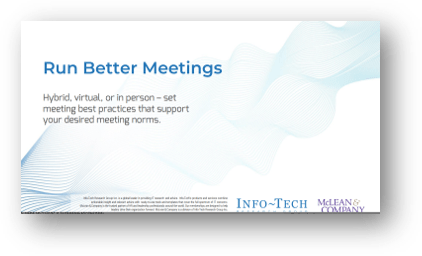Define Your Virtual and Hybrid Event Requirements

Your organization is considering holding an event online, or has been, but:
- The organization (both on the business and IT sides) may not have extensive experience hosting events online.
- It is not immediately clear how your formerly in-person event’s activities translate to a virtual environment.
- Like the work-from-home transformation, bringing events online instantly expands IT’s role and responsibilities.
Our Advice
Critical Insight
If you don't begin with strategy, you will fit your event to technology, instead of the other way around.
Impact and Result
To determine your requirements:
- Determine the scope of the event.
- Narrow down your list of technical requirements.
- Use Info-Tech’s Rapid Application Selection Framework to select the right software solution.
Define Your Virtual and Hybrid Event Requirements Research & Tools
Besides the small introduction, subscribers and consulting clients within this management domain have access to:
1. Define Your Virtual and Hybrid Event Requirements Storyboard – Use this storyboard to work through key decision points involved in creating digital events.
This deck walks you through key decision points in creating virtual or hybrid events. Then, begin the process of selecting the right software by putting together the first draft of your requirements for a virtual event software solution.
- Define Your Virtual and Hybrid Event Requirements Storyboard
2. Virtual Events Requirements Tool – Use this tool to begin selecting your requirements for a digital event solution.
The business should review the list of features and select which ones are mandatory and which are nice to have or optional. Add any features not included.
- Virtual/Hybrid Event Software Feature Analysis Tool
Further reading
Define Your Virtual and Hybrid Event Requirements
Accelerate your event scoping and software selection process.
Analyst Perspective
When events go virtual, IT needs to cover its bases.
The COVID-19 pandemic imposed a dramatic digital transformation on the events industry. Though event ticket and registration software, mobile event apps, and onsite audio/visual technology were already important pieces of live events, the total transformation of events into online experiences presented major challenges to organizations whose regular business operations involve at least one annual mid-sized to large event (association meetings, conferences, trade shows, and more).
Many organizations worked to shift to online, or virtual events, in order to maintain business continuity. As time went on, and public gatherings began to restart, a shift to “hybrid” events began to emerge—events that accommodate both in-person and virtual attendance. Regardless of event type, this pivot to using virtual event software, or digital event technology, brings events more closely into IT’s areas of responsibility. If you don't begin with strategy, you risk fitting your event to technology, instead of the other way around.
If virtual and hybrid events are becoming standard forms of delivering content in your organization, use Info-Tech’s material to help define the scope of the event and your requirements, and to support your software selection process.

Emily Sugerman
Research Analyst, Infrastructure & Operations
Info-Tech Research Group
Executive Summary
Your ChallengeThe organization (both on the business and IT sides) may not have extensive experience hosting events online. It is not immediately clear how a formerly in-person event’s activities translate to a virtual environment. Like the work-from-home transformation, bringing events online expands IT’s role and responsibilities. |
Common ObstaclesIt is not clear what technological capabilities are needed for the event, which capabilities you already own, and what you may need to purchase. Though virtual events remove some barriers to attendance (distance, travel), it introduces new complications and considerations for planners. Hybrid events introduce another level of complexity. |
Info-Tech’s ApproachIn order to determine your requirements: Determine the scope of the event. Narrow down your list of technical requirements. Use Info-Tech’s Rapid Application Selection Framework to select the right software solution. |
Info-Tech Insight
If you don't begin with strategy, you will fit your event to technology, instead of the other way around.
Your challenge
The solution you have been using for online events does not meet your needs.
Though you do have some tools that support large meetings, it is not clear if you require a larger and more comprehensive virtual event solution. There is a need to determine what type of technology you might need to purchase versus leveraging what you already have.
It is difficult to quickly and practically identify core event requirements and how they translate into technical capabilities.
Maintaining or improving audience engagement is a perpetual challenge for virtual events.
|
38%
|
21%
|
40%
|
Source: Virtual Event Tech Guide, 2022
Common obstacles
These barriers make this challenge difficult to address for many organizations.
Events with networking objectives are not always well served by webinars, which are traditionally more limited in their interactive elements.
Events that include the conducting of organizational/association business (like voting) may have bylaws that make selecting a virtual solution more challenging.
Maintaining attendee engagement is more challenging in a virtual environment.
Prior to the pandemic, your organization may not have been as experienced in putting on fully virtual events, putting more responsibility in your corner as IT. Navigating virtual events can also require technological competencies that your attendee userbase may not universally possess.
Technological limitations and barriers to access can exclude potential attendees just as much as bringing events online can open up attendance to new audiences.
Opportunity: Virtual events can significantly increase an event’s reach
Events held virtually during the pandemic noted significant increases in attendees.
“We had 19,000 registrations from all over the world, almost 50 times the number of people we had expected to host in Amsterdam. . . . Most of this year’s [2020] attendees would not have been able to participate in a physical GrafanaCon in Amsterdam. That was a huge win.” – Raj Dutt, Grafana Labs CEO[5]
| Event | In-person | Online | 2022 |
| Microsoft Build | 2019: 6,000 attendees | 2020: 230,000+ registrants[1] | The 2022 conference was also held virtually[3] |
| Stanford Institute for Human-Centered Artificial Intelligence | A few hundred attendees expected for the original (cancelled) 2020 in-person conference | 2020: 30,000 attendees attended the “COVID-19 and AI” virtual conference[2] | The 2022 Spring Conference was a hybrid event[4] |
[1] Kelly, 2020; [2] Price, 2020; [3] Stanford Digital Economy Lab, 2022; [4] Warren, 2022; [5] Fast Company, 2020
Info-Tech’s methodology for defining virtual/hybrid event requirements
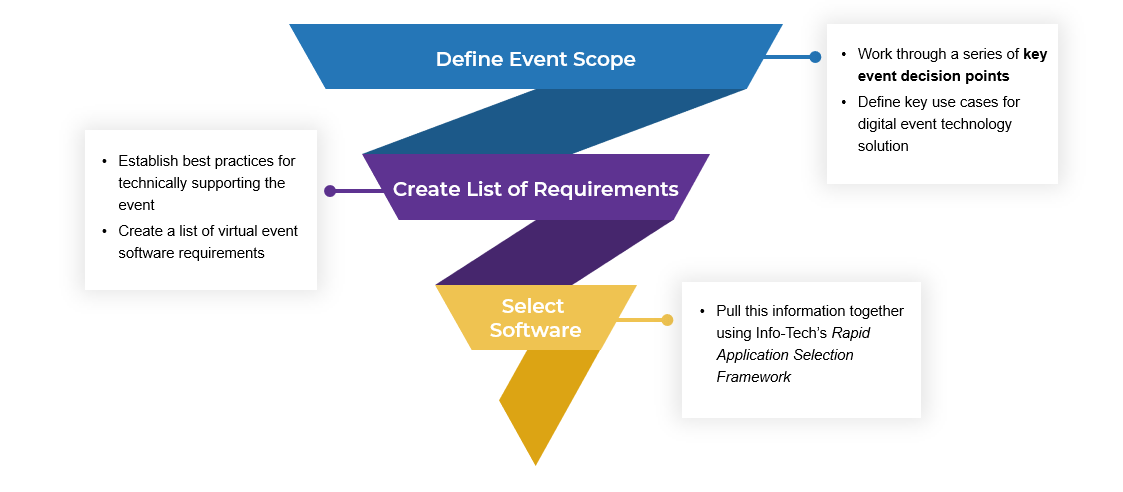
Event planning phases
Apply project management principles to your virtual/hybrid event planning process.
Online event planning should follow the same established principles as in-person event planning.
Align the event’s concept and objectives with organizational goals.
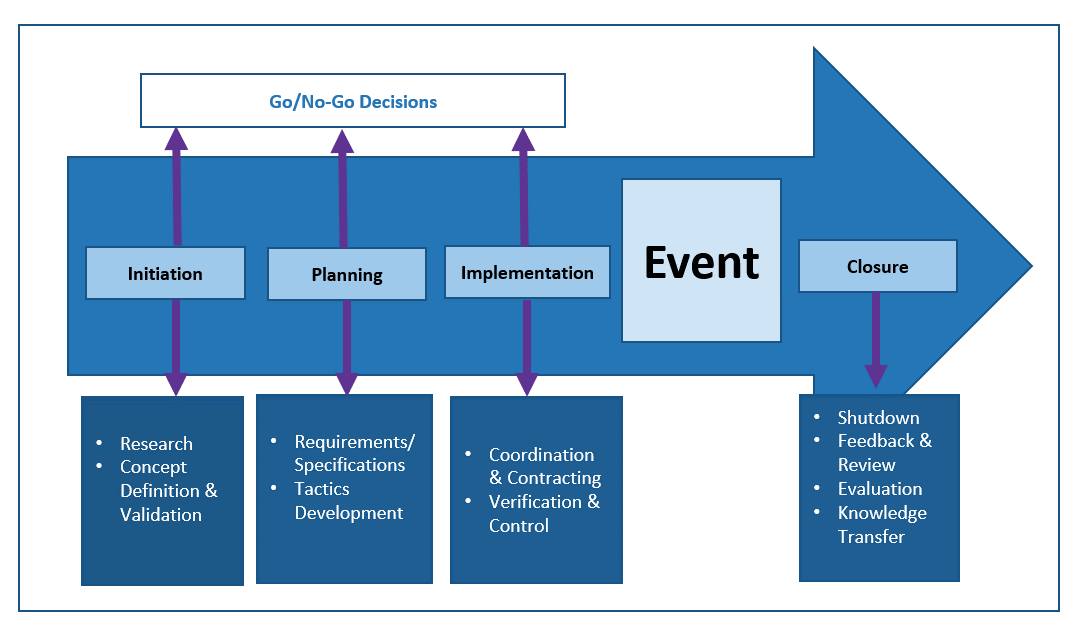
Source: Adapted from Event Management Body of Knowledge, CC BY 4.0
Gather inputs to the planning processes
Acquire as much of this information as possible before you being the planning process.
Budget: Determine your organization’s budget for this event to help decide the scope of the event and the purchasing decisions you make as you plan.
Internal human resources: Identify who in your organization is usually involved in the organization of this event and if they are available to organize this one.
List of communication and collaboration tools: Acquire the list of the existing communication and collaboration tools you are currently licensed for. Ensure you know the following information about each tool:
- Type of license
- License limitations (maximum number of users)
- Internal or external-facing tool (or capable of both)
- Level of internal training and competency on the tool
Decision point: Relate event goals to organizational goals
What is driving the event?
Your organization may hold a variety of in-person events that you now wish, for various reasons, to hold fully or partially online. Each event likely has a slightly different set of goals.
Before getting into the details of how to transition your event online, return to the business/organizational goals the event is serving.
Ensure each event (and each component of each event) maps back to an organizational goal.
If a component of the event does not align to an organizational goal, assess whether it should remain as part of the event.
Common organizational goals
- Increase revenue
- Increase productivity
- Attract and retain talent
- Improve change management
- Carry out organizational mission
- Identify new markets
- Increase market share
- Improve customer service
- Launch new product/service
Common event goals
- Education/training
- Knowledge transfer
- Decision making
- Professional development
- Sales/lead generation
- Fundraising
- Entertainment
- Morale boosting
- Recognition of achievement
Decision point: Identify your organization’s digital event vision
What do you want the outcome of this event to be?
Attendee goals: Who are your attendees? Why do they attend this event? What attendee needs does your event serve? What is your event’s value proposition? Are they intrinsically or extrinsically motivated to attend?
Event goals: From the organizer perspective, why do you usually hold this event? Who are your stakeholders?
Organizational goals: How do the event goals map to your organizational goals? Is there a clear understanding of what the event’s larger strategic purpose is.
Common attendee goals
Education: our attendees need to learn something new that they cannot learn on their own.
Networking: our attendees need to meet people and make new professional connections.
Professional development: our attendees have certain obligations to keep credentials updated or to present their work publicly to advance their careers.
Entertainment: our attendees need to have fun.
Commerce: our attendees need to buy and sell things.
Decision point: Level of external event production
Will you be completely self-managed, reliant on external event production services, or somewhere in the middle?
You can review this after working through the other decision points and the scope becomes clearer.

Decision point: Assign event planning roles
Who will be involved in planning the event? Fill/combine these roles as needed.
| Planning roles | Description |
| Project manager | Shepherd event planning until completion while ensuring project remains on schedule and on budget. |
| Event manager | Correspond with presenters during leadup to event, communicate how to use online event tools/platform, perform tests with presenters/exhibitors, coordinate digital event staff/volunteers. |
| Program planner | Select the topics, speakers, activity types, content, streams. |
| Designer and copywriter | Design the event graphics; compose copy for event website. |
| Digital event technologist | Determine event technology requirements; determine how event technology fits together; prepare RFP, if necessary, for new hardware/software. |
| Platform administrator | Set up registration system/integrate registrations into platform(s) of choice; upload video files and collateral; add livestream links; add/delete staff roles and set controls and permissions; collect statistics and recordings after event. |
| Commercial partner liaison | Recruit sponsors and exhibitors (offer sponsorship packages); facilitate agreement/contract between commercial partners and organization; train commercial partners on how to use event technology; retrieve lead data. |
| Marketing/social media | Plan and execute promotional campaigns (email, social media) in the lead up to, and during, the event. Post-event, send follow-up communications, recording files, and surveys. |
Decision point: Assign event production roles
Who will be involved in running the event?
| Event production roles | Description |
| Hosts/MCs |
Address attendees at beginning and end of event, and in-between sessions Provide continuity throughout event Introduce sessions |
| Producers |
Prepare presenters for performance Begin and end sessions Use controls to share screens, switch between feeds Send backchannel messages to presenters (e.g., "Up next," "Look into webcam") |
| Moderators |
Admit attendees from waiting room Moderate incoming questions from attendees Manage slides Pass questions to host/panelists to answer Moderate chat |
| IT support |
Manage event technology stack Respond to attendee technical issues Troubleshoot network connectivity problems Ensure audio and video operational Start and stop session recording Save session recordings and files (chat, Q&As) |
Decision point: Map attendee goals to event goals to organizational goals
Input: List of attendee benefits, List of event goals, List of organizational goals
Output: Ranked list of event goals as they relate to attendee needs and organizational goals
Materials: Whiteboard/flip charts
Participants: Planning team
-
Define attendee benefits:
- List the attendee benefits derived from your event (as many as possible).
- Rank attendee benefits from most to least important.
-
Define event goals:
- List your event goals (as many as possible).
- Draw a connecting line to your ranked list of attendee benefits.
- Identify if any event goals exist with no clear relationship to attendee benefits. Discuss whether this event goal needs to be re-envisioned. If it connects to no discernible attendee benefits, consider removing it. Otherwise, figure out what attendee benefits the event goal provides.
-
Define organizational goals:
- Acquire a list of your organization’s main strategic goals.
- Draw a connecting line from each event goal to the organizational goal it supports.
- If most of your event goals do not immediately seem to support an organizational goal, discuss why this is. Try to find the connection. If you cannot, discuss whether the event should proceed or be rethought.
Decision point: Break down your event into its constituent components
Identify your event archetype
Decompose the event into its component parts
Identify technical requirements that help meet event goals
Benefits:
- Clarify how formerly in-person events map to virtual archetypes.
- Ensure your virtual event planning is anchored to organizational goals from the outset.
- Streamline your virtual event tech stack planning later.
Decision point: Determine your event archetype
Analyze your event’s:
- Main goals.
- The components and activities that support those goals.
- How these components and activities fall into people- vs. content-centric activities, and real-time vs. asynchronous activities.
- Conference
- Trade show
- Annual general meeting
- Department meeting
- Town hall
- Workshop
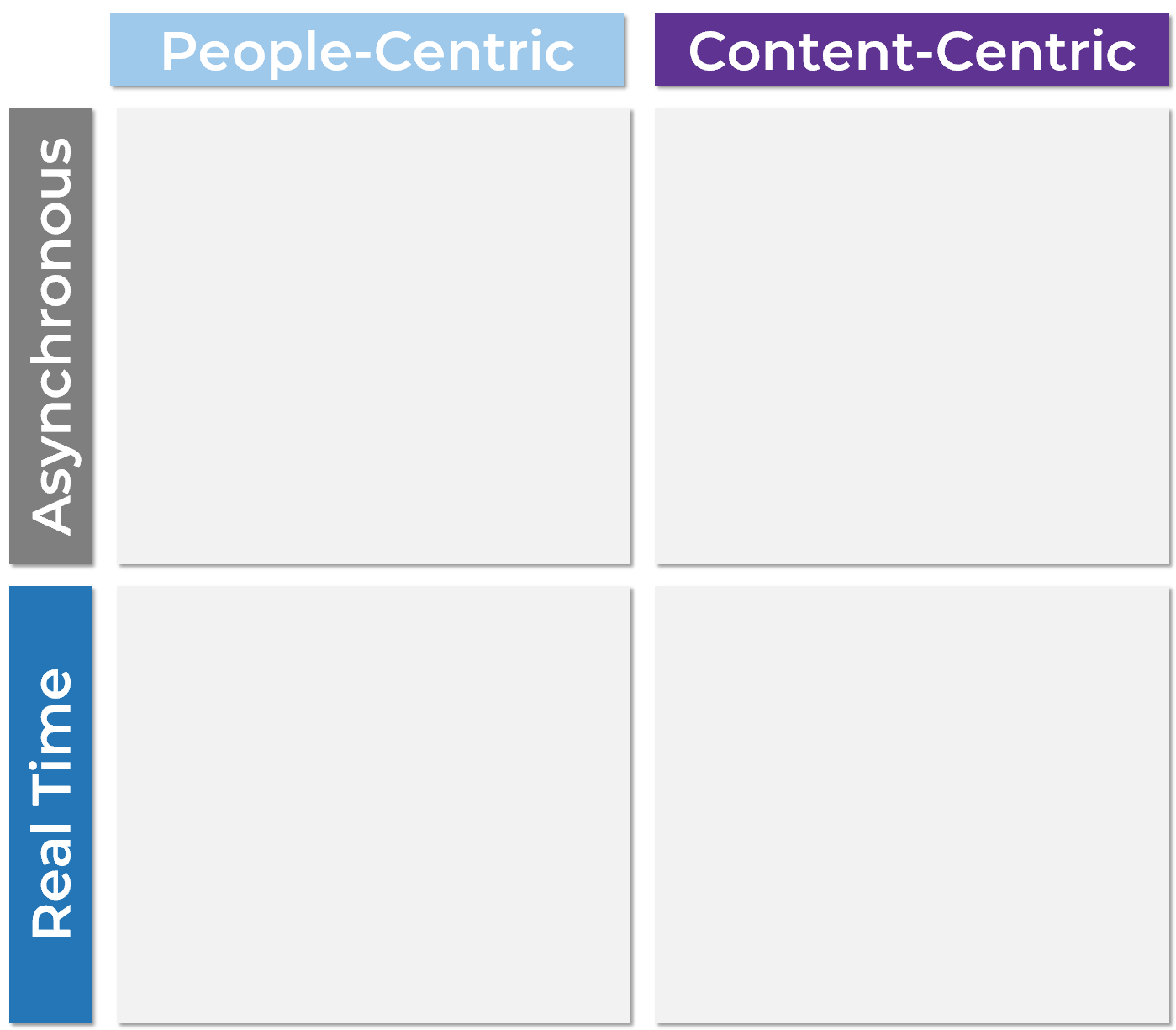
Info-Tech Insight
Begin the digital event planning process by understanding how your event’s content is typically consumed. This will help you make decisions later about how best to deliver the content virtually.
Conference
Goals: Education/knowledge transfer; professional advancement; networking.
Major content
- Call for proposals/circulation of abstracts
- Keynotes or plenary address: key talk addressed to large audience
- Panel sessions: multiple panelists deliver address on common theme
- Poster sessions: staffed/unstaffed booths demonstrate visualization of major research on a poster
- Association meetings (see also AGM archetype): professional associations hold AGM as one part of a larger conference agenda
Community
- Formal networking (happy hours, social outings)
- Informal networking (hallway track, peer introductions)
- Business card exchange
- Pre- and post-event correspondence
Commercial Partners
- Booth reps: Publishing or industry representatives exhibit products/discuss collaboration
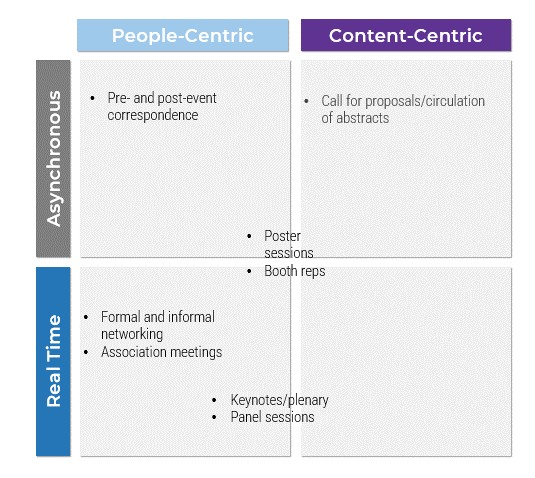
Trade show
Objectives: Information transfer; sales; lead generation.
Major content
- Live booth reps answer questions
- Product information displayed
- Promotional/information material distributed
- Product demonstrations at booths or onstage
- Product samples distributed to attendees
Community interactions
- Statements of intent to buy
- Lead generation (badge scanning) of booth visitors
- Business card exchange
- Pre- and post-event correspondence
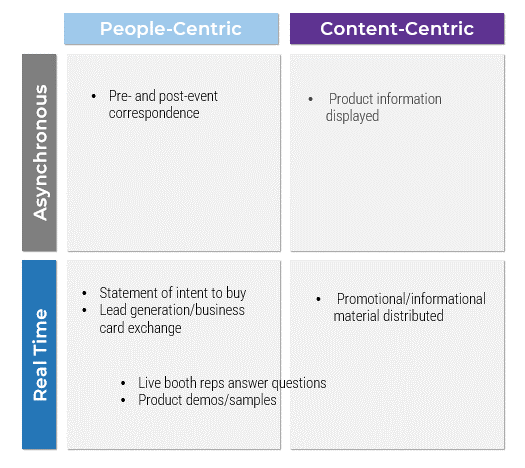
Annual general meeting
Objectives: Transparently update members; establish governance and alignment.
Meeting events
- Updates provided to members on organization’s activities/finances
- Decisions made regarding organization’s direction
- Governance over organization established (elections)
- Speakers addressing large audience from stage
- In-camera sessions
- Translation of proceedings
- Real-time weighted voting
- Minutes taken during meeting
Administration
- Notice given of meeting within mandated time period
- Agenda circulated prior to meeting
- Distribution of proxy material
- Minutes distributed
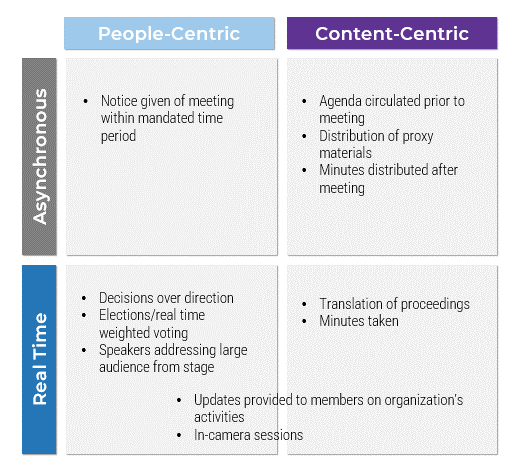
Department meeting
Objectives: Information transfer of company agenda/initiatives; group decision making.
Major content
- Agenda circulated prior to meeting
- Updates provided from senior management/leadership to employees on organization’s initiatives and direction
- Employee questions and feedback addressed
- Group decision making
- Minutes taken during meeting
- Minutes or follow-up circulated
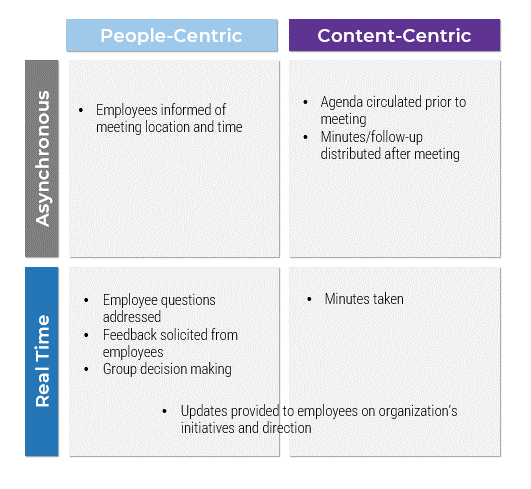
Town hall meeting
Objectives: Update public; answer questions; solicit feedback.
Major content
- Public notice of meeting announced
- Agenda circulated prior to meeting
- Speakers addressing large audience from stage
- Presentation of information pertinent to public interest
- Audience members line up to ask questions/provide feedback
- Translation of proceedings
- Recording of meeting archived
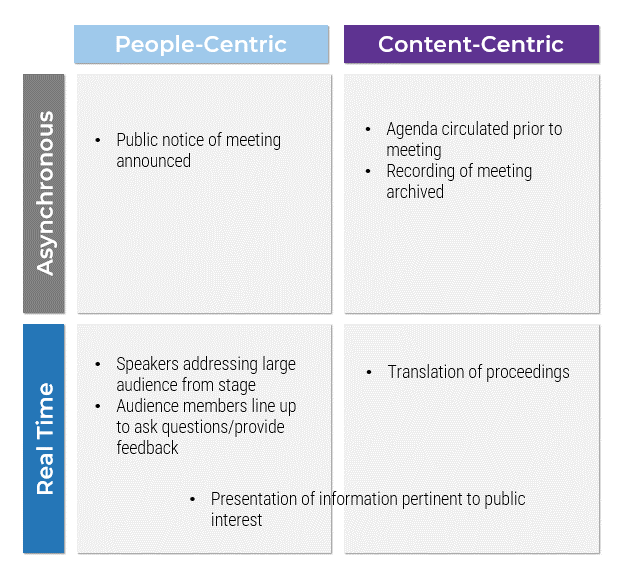
Workshop
Objectives: Make progress on objective; achieve consensus; knowledge transfer.
Major content
- Scheduling of workshop
- Agenda circulated prior to meeting
- Facilitator leads group activities
- Participants develop alignment on project
- Progress achieved on workshop project
- Feedback on workshop shared with facilitator
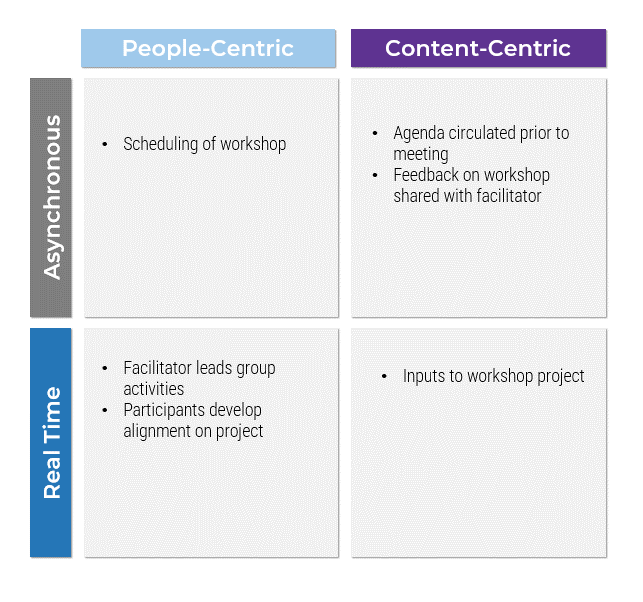
Decision point: Analyze your event’s purpose and value
Use the event archetypes to help you identify your event’s core components and value proposition.
- Attendee types: Who typically attends your event? Exclusively internal participants? External participants? A mix of the two?
- Communication: How do participants usually communicate with each other during this event? How do they communicate with the event organizers? Include both formal types of communication (listening to panel sessions) and informal (serendipitous conversations in the hallway).
- Connection: What types of connections do your attendees need to experience? (networking with peers; interactions with booth reps; consensus building with colleagues).
- Exchange of material: What kind of material is usually exchanged at this event and between whom? (Pamphlets, brochures, business cards, booth swag).
- Engagement: How do you usually retain attendees' attention and make sure they remain engaged throughout the event?
- Length: How long does the event typically last?
- Location and setup: Where does the event usually take place and who is involved in its setup?
- Success metrics: How do you usually measure your event's success?
Info-Tech Insight
Avoid trying to exactly reproduce the formerly in-person event online. Instead, identify the value proposition of each event component, then determine what its virtual expression could be.
Example: Trade show
Goals: Information transfer; sales; lead generation.
- Identify event component(s)
- Document its face-to-face expression(s)
- Identify the expression’s value proposition
- Translate the value proposition to a virtual component that facilitates overall event goal
Event component |
Face-to-face expression |
Value proposition of component |
Virtual expression |
| Attendee types | Paying attendees | Revenue for event organizer; sales and lead generation for booth rep | Access to virtual event space |
| Attendee types | Booth rep | Revenue for event organizer; information source for paying attendees | Access to virtual event space |
| Communication/connection | Conversation between booth rep and attendee | Lead generation for booth rep; information to inform decision making for attendee | Ability to enter open video breakout session staffed by booth reps OR Ability to schedule meeting times with booth rep Multiple booth reps on hand to monitor different elements of the booth (one person to facilitate the discussion over video, another to monitor chat and Q&A) |
| Communication/connection | Serendipitous conversation between attendees | Increased attendee contacts; fun | Multiple attendees can attend the booth’s breakout session simultaneously and participate in web conferencing, meeting chat, or submit questions to Q&A |
| Communication/connection | Badges scanned at booth/email sign-up sheets filled out at table | Lead generation for exhibitors | List of visitors to booth shared with exhibitor (if consent given by attendees) Ability for attendees to request to be contacted for more information |
| Exchange of material | Catering (complimentary coffee, pastries) | Obviate the need for attendees to leave the event for refreshments | N/A: not included in virtual event |
| Exchange of material | Pamphlets, product literature, swag | Portable information for attendee decision making | Downloadable files (pdf) |
| Location | Responsibility of both the organizers (tables, chairs, venue) and booth reps (posters, handouts) | Booth reps need a dedicated space where they can be easily found by attendees and advertise themselves | Booth reps need access to virtual platform to upload files, images, provide booth description |
| Engagement | Attendees able to visit all booths by strolling through space | Event organizers have a captive audience who is present in the immediacy of the event site | Attendees motivated to stay in the event space and attend booths through gamification strategies (points awarded for number of booths visited or appointments booked) |
| Length of event | 2 full days | Attendees travel to event site and spend the entire 2 days at the event, allowing them to be immersed in the event and absorb as much information in as little time as possible | Exhibitors’ visiting hours will be scheduled so they work for both attendees attending in Eastern Standard Time and Pacific Time |
| Metrics for success | -Positive word of mouth -Number of registrations |
These metrics can be used to advertise to future exhibitors and attendees | Number of virtual booths visited Number of file downloads Survey sent to attendees after event (favorite booths, preferred way to interact with exhibitors, suggestions for improvement, most valuable part of experience) |
Plan your metrics
Use the analytics and reporting features available in your event technology toolset to capture the data you want to measure. Decide how each metric will impact your planning process for the next event.
Examples of metrics:
- Number of overall participants/registrants: Did you have more or fewer registrants/attendees than previous iterations of the event? What is the difference between number of registrants and number of real attendees?
- Locations of participants: Where are people participating from? How many are attending for the first time? Are there new audiences you can pursue next time?
- Most/least popular sessions: How long did people stay in the sessions and the event overall?
- Most/least popular breakout rooms and discussion boards: Which topics should be repeated/skipped next time?
- Social media mentions: Which topics received the most engagement on social media?
- Surveys: What do participants report enjoying most? Least?
- Technical failures: Can your software report on failures? Identify what technical problems arose and prepare a plan to mitigate them next time.
Ensure the data you capture feeds into better planning for the next event
Determine compliance requirements
A greater event reach also means new data privacy considerations, depending on the location of your guests.
General Data Protection Regulation (GDPR)
Concerns over the collection of personal electronic data may not have previously been a part of your event planning considerations. However, now that your event is online, it’s wise to explore which data protection regulations apply to you. Remember, even if your organization is not located in the EU, if any of your attendees are European data subjects you may still be required to comply with GDPR, which involves the notification of data collected, allowing for opt-out options and the right to have data purged. The data must be collected for a specific purpose; if that purpose is expired, it can no longer be retained. You also have an obligation to report any breaches.
Accessibility requirements
What kind of accessibility laws are you subject to (AODA, WCAG2)? Regardless of compliance requirements, it is a good idea to ensure the online event follows accessibility best practices.
Decision point: Set event policies
What event policies need to be documented?
How will you communicate them to attendees?
Code of conduct
One trend in the large event and conference space in recent years has been the development of codes of conduct that attendees are required to abide by to continue participating in the event.
Now that your event is online, consider whether your code of conduct requires updating. Are there new types of appropriate/inappropriate online behavior that you need to define for your attendees?
Harassment reporting
If your organization has an event harassment reporting process, determine how this process will transfer over to the digital event.
Ensure the reporting process has an owner and a clear methodology to follow to deal with complaints, as well as a digital reporting channel (a dedicated email or form) that is only accessed by approved staff to protect sensitive information.
Develop a risk management plan
Plan for how you will mitigate technical risks during your virtual event
Provide presenters with a process to follow if technical problems arise.
- Presenter’s internet connection cuts out
- Attendees cannot log in to event platform
- Attendees cannot hear/see video feed
- What process will be followed when technical problems occur: ticketing system; chatbot; generic email accessible by all IT support assigned
Testing/Rehearsal
Test audio hardware: Ensure speakers use headphones/earbuds and mics (they do not have to be fancy/expensive). Relying on the computer/laptop mic can lead to more ambient noise and potential feedback problems.
Check lighting: Avoid backlighting. Reposition speakers so they are not behind windows. Ask them to open/close shades. Add lamps as needed.
Prevent interruptions: Before the event, ask panelists to turn phone and computer notifications to silent. Put a sign on the door saying Do not Disturb.
Control audience view of screenshare: If your presenters will be sharing their screens, teach them how this works on the platform they are using. Advise them to exit out of any other application that is not part of their presentation, so they do not share the wrong screen unintentionally. Advise them to remove anything from the desktop that they do not want the audience to see, in case their desktop becomes visible at any point.
Control audience view of physical environment: Before the event, advise participants to turn their cameras on and examine their backgrounds. Remove anything the audience should not be able to see.
Test network connectivity: Send the presenters a link to a speed test and check their internet speed.
Emergency contact: Exchange cell phone numbers for emergency backchannel conversations if problems arise on the day of the event.
Set expectations: Presenting to an online audience feels very different to a live crowd. Prepare presenters for a lack of applause and lack of ability to see their audience, and that this does not mean the presentation was unsuccessful.
Identify requirements
To determine what kind of technical requirements you need to build the virtual expression of your event, consult the Virtual Event Platform Requirements Tool.
- If you have determined that the requirements you wish to use for the event exceed the capabilities of your existing communication and collaboration toolset, identify whether these gaps tip the scale toward purchasing a new tool. Use the requirement gaps to make the business case for purchasing a new tool.
- Use the Virtual Event Platform Requirements Tool to create a list of requirements.
- Consult the Software Reviews category for Virtual Event Platform Data Quadrant and Emotional Footprint reports.
- Assemble your documentation for approvals and the Rapid Application Selection Process.
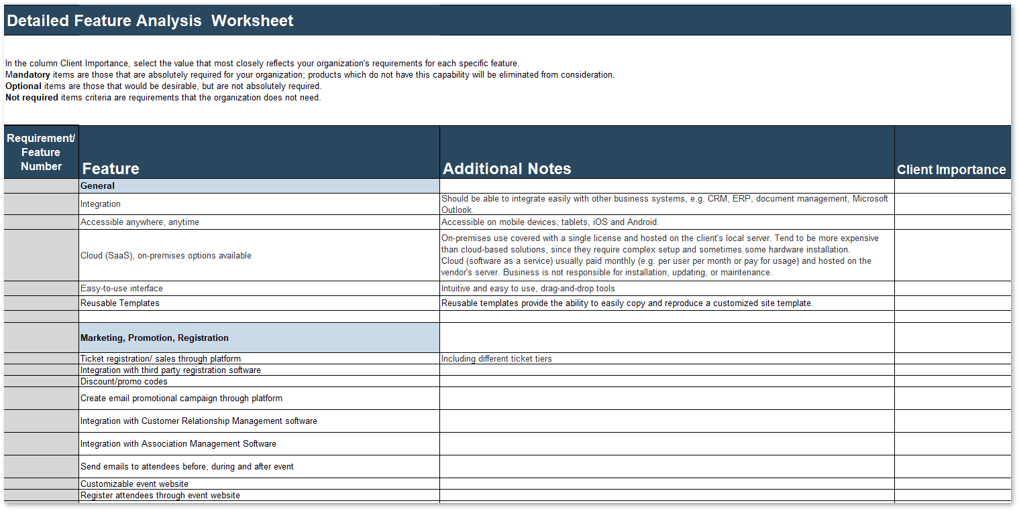
Download the Virtual/Hybrid Event Software Feature Analysis Tool
Rapid Application Selection Framework and Contract Review
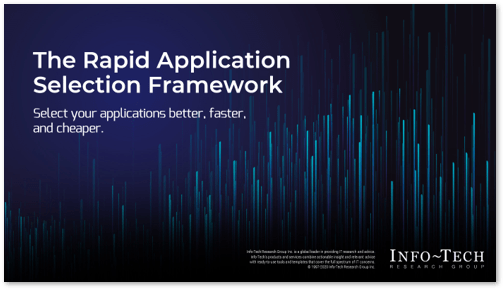
Launch Info-Tech’s Rapid Application Selection Framework.
Using the requirements you’ve just gathered as a base, use Info-Tech’s complete framework to improve the efficiency and effectiveness of software selection.
Once you’ve selected a vendor(s), review the contract. Does it define an exit strategy? Does it define when your data will be deleted? Does it set service-level agreements that you find acceptable? Leverage Info-Tech’s contract review service once you have selected the virtual event solution and have received a contract from the vendor.
Further research
Bibliography
Dutt, Raj. “7 Lessons from This Company’s First-Ever Virtual Conference.” Fast Company, 29 Jul 2020. Web.
Kelly, Samantha Murphy. “Microsoft Build Proves Splashy Tech Events Can Thrive Online.” CNN, 21 May 2020. Web.
“Phases.” Event Management Body of Knowledge (EMBOK), n.d. Web.
Price, Michael. “As COVID-19 Forces Conferences Online, Scientists Discover Upsides of Virtual Format.” Science, 28 Apr 2020. Web.
“Stanford HAI Spring Conference - Key Advances in Artificial Intelligence.” Stanford Digital Economy Lab, 2022. Web.
“Virtual Event Tech Guide 2022.” Skift Meetings, April 2022. Web.
Warren, Tom. “Microsoft Build 2022 Will Take Place May 24th–26th.” The Verge, 30 March 2022. Web.
Contributors
6 anonymous contributors
Buying Options
Define Your Virtual and Hybrid Event Requirements
IT Risk Management · IT Leadership & Strategy implementation · Operational Management · Service Delivery · Organizational Management · Process Improvements · ITIL, CORM, Agile · Cost Control · Business Process Analysis · Technology Development · Project Implementation · International Coordination · In & Outsourcing · Customer Care · Multilingual: Dutch, English, French, German, Japanese · Entrepreneur
Tymans Group is a brand by Gert Taeymans BV
Gert Taeymans bv
Europe: Koning Albertstraat 136, 2070 Burcht, Belgium — VAT No: BE0685.974.694 — phone: +32 (0) 468.142.754
USA: 4023 KENNETT PIKE, SUITE 751, GREENVILLE, DE 19807 — Phone: 1-917-473-8669
Copyright 2017-2022 Gert Taeymans BV
